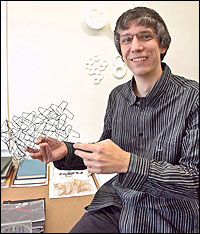Archives
Finding beauty in ’blankness’
Architect favors approach that puts power in hands of buildings’ users
By KEVIN FRYLING
Reporter Staff Writer
A desire to pursue an interest in “architectural blankness,” a progressive approach to architectural design that puts the ultimate look and feel of a building in the hands of the people who use it—not the architects who create it—prompted a former member of a top architectural firm in England to join the UB architecture faculty last fall.

Sergio López-Piñeiro
holds a model designed for a nongovernmental organization in Kenya to
help prevent thefts of computers.
PHOTO: NANCY J. PARISI
Sergio López-Piñeiro, who served as an adjunct UB faculty member as the 2006-07 Peter Reyner Banham Fellow, brings to the university several years’ experience as an architect at Foreign Office Architects, a London-based architectural firm whose work includes the master plan for the 2012 Summer Olympics and a proposal submitted to the design committee for the reconstruction of Ground Zero in New York City.
“I’ve always been interested in undermining the power of architects—power in the social and aesthetic sense,” says López-Piñeiro, a native of Spain. “Blank architecture is about a change in the way architects produce architecture—it’s about trying to leave the architectural product open for change and interpretation by citizens.”
He and two senior architecture students, Saki Yoshimura and Kin Chun Ma, are participating in three design competitions in which their submissions are prime examples of these principles—the proposed structures will not be “complete” until certain important elements are supplied by the people who will use the buildings, he says. The winners of one of those competitions, the AMD Open Architecture Challenge—a collaboration between microprocessor manufacturer Advanced Micro Devices and a volunteer nonprofit organization, Architecture for Humanity—will create the structures that house operations for three nongovernmental agencies: Sidarec in Kenya, Nyaya Health in Nepal and Kallari Association in Ecuador. López-Piñeiro says the proposal for Sidarec, which would teach such job skills as Web design to African youth, lays out plans for an open structure in which the side walls will consist of art created by the students. Kenya’s tropical climate means traditional walls can be rethought, he adds.
“Generally,” he says, “architects are responsible for every single aspect of a building. Blank architecture is seen more as infrastructure, not as much as a finished object. It allows citizens to project their own images onto the object—to appropriate it as they see fit.”
Blank architecture “accepts that blankness is going to disappear when the citizens take over,” he adds, noting that emptiness is not “enforced” here as it is in movements such as minimalism. “In a way,” he says, “it accepts its own self-destruction.”
As the Reyner Banham Fellow, López-Piñeiro spent last year fine-tuning his thoughts on architectural blankness for an upcoming book, “The Enabler.” The title, he says, refers to his belief that the structures architects create enable their users to fulfill their “dreams and desires and needs,” but also acknowledges that these goals are frequently accomplished in an ultimately destructive way. He says, for instance, that too often architects create designs that require construction material from countries that exploit workers—or employ power-hungry technology.
“The built environment created by architects is very responsible for global warming,” López-Piñeiro says. “Maybe architects in the past weren’t as aware of the problems they were causing, but most architects tend to rely on technological solutions, such as air conditioning—regardless of the context in which they are building—instead of exploring other, less globally damaging solutions that might be available in that particular context.”
Two sections of the book will focus on his work and the work of his students, he adds, with a third based on a course he taught last spring entitled, “Architectural Blankness.”
“Teaching is not only a very fulfilling activity,” he says, “but it’s also very energizing from a work point of view. There are a lot of really interesting surprises. If you tell something to a student, they usually pick it up from a different angle—they’re able to tweak it or turn it upside down—and suddenly a new project emerges.”
This semester he is teaching one of six sophomore architecture studios, as well as serving as course coordinator for the others.
The recipient of a master’s degree in architecture from Princeton University and a diploma in architecture from ETS Arquitectura, Universidad Politécnica in Madrid, Spain, López-Piñeiro has taught as a visiting lecturer at the Institute for Advanced Architecture of Catalina in Barcelona, Spain; as an adjunct assistant professor at Temple University; and as lecturer at the University of California-Berkeley before coming to UB. He also spent two years at an architectural firm in Madrid before joining Foreign Office Architects.
“There are quite a few things I like about this place,” López-Piñeiro says of UB. “I’m a real believer in the public university and really want to make a difference in the education of the students here, who come from such a wide array of backgrounds. I also truly believe that the undergraduate program in the architecture department is strong—and getting stronger. The students are very well-motivated and the program is very well-structured.”
A resident of Madrid until age 27, López-Piñeiro moved to the United States five and a half years ago, two of which have been spent in Buffalo. He resides in the Elmwood Village neighborhood of Buffalo with his partner, Joyce Hwang, assistant professor of architecture in the School of Architecture and Planning.
Although it surprises many people, López-Piñeiro says winter is one of his favorite things about Buffalo. “I love when the snow turns everything white because it looks sort of blank,” he laughs. “When the campus is completely white, it’s beautiful. People suddenly start walking where they want to—they don’t respect the lawn, they don’t respect the walks—suddenly the limits have been erased. In a way, my ideas might be influenced by the city.”
